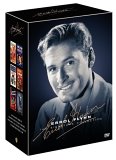Synopsis
Captain Blood (1935) is the picture that made Errol Flynn a star, and paired him for the first time of many with Olivia De Havilland. There had been pirate movies before (Douglas Fairbanks was the star in them), but this became the new high watermark of the genre. Flynn plays a doctor who is unjustly accused of treason and shipped off to a life of slavery in the colonies. He fights back, eventually becoming the pirate of the title, but always remaining an honourable man, of course. Th…s is a terrific swashbuckler, and its worthy descendant today would not be the entertaining but shallow Pirates of the Carribean, but Master and Commander.
Dodge City (1939) is a lavish western, and Flynn was unsure about his suitability for the genre. But he shines effortlessly as the cowboy who is convinced at length to become the sheriff and clean up Dodge City. Every western element that would later be a cliché is present in glorious Technicolor glory, including one of the most spectacular saloon brawls ever committed to film. Alan Hale does his sterling comic sidekick work, and he shows up in most of the films in this collection too.
Flynn was back in more familiar period costume in The Private Lives of Elizabeth and Essex (1939), where he plays opposite a deglamourized Bette Davis. There is far less buckling of swashes going on here, and much more drama as we follow the turbulent and doomed romance. Flynn shows off his acting chops, more than holding his own against Davis (try to name an action star of which the same could be said today).
The Sea Hawk (1940) recycles many of the sets and much of the cast of the previous film, and even keeps the same historical period, but we’re back in full-on adventure here, taking the pirate film to levels even higher than Captain Blood. This time, Flynn is a privateer in the service of Elizabeth, wreaking havoc with Spain’s plans of conquest. Adventure films don’t get much better than this.
They Died With Their Boots On (1941) sees Flynn playing General Custer, and turning him into a compelling, sympathetic figure. So much of the film is light-hearted, as the happy-go-lucky Custer rises flamboyantly through the ranks, ignoring any and all rules, that when the last act takes its inevitable dark hue, the sense of tragedy is deeply felt.
Audio
Mono is the order of the day here, and the tracks all do their job honourably. Despite the ages of the films, the sound is warm, crisp, and almost completely free of distortion. I’ve heard far more recent stereo tracks that sounded tinnier than this.
Video
The transfers are good, too, for the most part. The black-and-white tones are very strong, the prints are in good shape, and there is, generally speaking, very little grain. There are some rough moments: Captain Blood has some moments where the faces of people in the near background disappear, and The Sea Hawk has some very grainy moments. Elizabeth and Essex and Dodge City are in colour, and though the latter looks great, the former has a fair bit of blurriness and bleed.
Special Features
Each disc comes with a featurette that looks at the making of the film, and where it fits in Flynn’s career, as well as a “Warner Night at the Movies” line-up. This means an introduction by the always perky Leonard Maltin, a trailer for another movie from that year, a contemporary newsreel (mostly covering the war in Europe, naturally), a short feature or two, and a cartoon. No commentaires, unfortunately, but there is an extra disc, with the feature-length documentary The Adventures of Errol Flynn (which is pretty fascinating, but still leaves one wanting more). The main screens of the menus are animated and scored.
Closing Thoughts
Every film here is a gem. I could wish the extras a bit more involved, but as classic collections go, this is very, very hard to beat.
Special Features List
- The Aventures of Errol Flynn Documentary
- Making-of Featurettes
- Newsreels
- Cartoons
- Trailers
- Short Features
- Leonard Maltin Introductions







